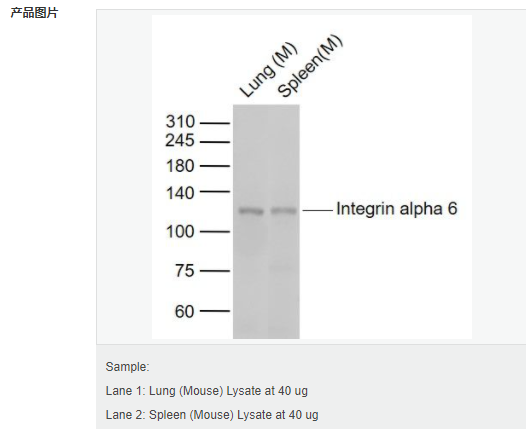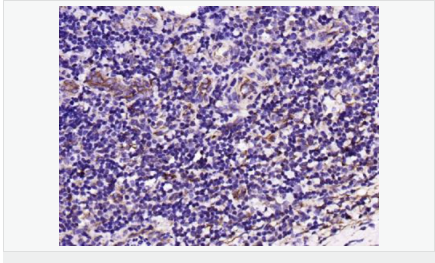
货号
产品规格
售价
备注
BN42119R-50ul
50ul
¥2020.00
交叉反应:Human,Mouse(predicted:Rat) 推荐应用:WB,IHC-P,IHC-F
BN42119R-100ul
100ul
¥3240.00
交叉反应:Human,Mouse(predicted:Rat) 推荐应用:WB,IHC-P,IHC-F
| 英文名称 | Integrin alpha 6 |
| 中文名称 | 整合素α6重组兔单克隆抗体 |
| 别 名 | Integrin alpha-6; Alpha6p; VLA 6 alpha subunit; VLA 6; VLA-6; Integrin α6; CD49 antigen-like family member F; CD49f; Integrin alpha6B; Integrin, alpha 6; ITA6_HUMAN; ITGA6; ITGA6B; Processed integrin alpha-6. |
| 研究领域 | 细胞生物 免疫学 信号转导 干细胞 细胞粘附分子 淋巴细胞 |
| 抗体来源 | Rabbit |
| 克隆类型 | Monoclonal |
| 克 隆 号 | 4F7 |
| 交叉反应 | Human, Mouse, (predicted: Rat, ) |
| 产品应用 | WB=1:500-1000 IHC-P=1:50-200 IHC-F=1:50-200 (石蜡切片需做抗原修复) not yet tested in other applications. optimal dilutions/concentrations should be determined by the end user. |
| 分 子 量 | 127kDa |
| 细胞定位 | 细胞膜 |
| 性 状 | Lyophilized or Liquid |
| 浓 度 | 1mg/ml |
| 免 疫 原 | Recombinant Human Integrin alpha 6:1-100/1130 |
| 亚 型 | IgG |
| 纯化方法 | affinity purified by Protein A |
| 储 存 液 | 1*TBS (pH7.4), 1%BSA, 40%Glycerol. Preservative: 0.05% Sodium Azide. |
| 保存条件 | Store at -20 °C for one year. Avoid repeated freeze/thaw cycles. The lyophilized antibody is stable at room temperature for at least one month and for greater than a year when kept at -20°C. When reconstituted in sterile pH 7.4 0.01M PBS or diluent of antibody the antibody is stable for at least two weeks at 2-4 °C. |
| PubMed | PubMed |
| 产品介绍 | Integrins are important extracellular matrix (ECM) receptor proteins located on cell surfaces. They are hetrodimers composed of an alpha and a beta transmembrane glycoprotein subunit. Around twenty two different integrins (different alpha/ beta subunit combinations) are found in nature. Integrins are generally present in high concentrations at the cell surface, but, unlike most other cell surface receptors, they bind ligands with very low affinity. Due to their weak individual binding, integrins need to cluster and bind in groups in order to effectively bind the ECM. Integrins bind many different ligands including laminin. Each integrin is made up of a large N terminal extracellular domain that binds the ECM ligand and a small C terminal cytoplasmic domain that mediates interaction with the actin cytoskeleton and signaling function. Integrin alpha 6 complexes are receptors for laminins, which are components of basement membranes. Integrin alpha 6 complexes may play an important role in embryogenesis. Function: Integrin alpha-6/beta-1 is a receptor for laminin on platelets. Integrin alpha-6/beta-4 is a receptor for laminin in epithelial cells and it plays a critical structural role in the hemidesmosome. Subunit: Heterodimer of an alpha and a beta subunit. The alpha subunit is composed of an heavy and a light chain linked by a disulfide bond. Alpha-6 associates with either beta-1 or beta-4. Interacts with HPS5. Interacts with RAB21. Subcellular Location: Cell membrane; Single-pass type I membrane protein. Tissue Specificity: Integrin alpha-6/beta-4 is predominantly expressed by epithelia. Isoforms containing segment X1 are ubiquitously expressed. Isoforms containing segment X1X2 are expressed in heart, kidney, placenta, colon, duodenum, myoblasts and myotubes, and in a limited number of cell lines; they are always coexpressed with the ubiquitous isoform containing segment X1. In some tissues (e.g. Salivary gland), isoforms containing cytoplasmic segment A and isoforms containing segment B are detected while in others, only isoforms containing one cytoplasmic segment are found (segment A in epidermis and segment B in kidney). Post-translational modifications: Isoforms containing segment A, but not segment B, are the major targets for PMA-induced phosphorylation. Phosphorylation occurs on 'Ser-1103' of isoform alpha-6X1X2A. Phosphorylation is not required for the induction of integrin alpha-6A/beta-1 high affinity but may reduce the affinity for ligand. DISEASE: Defects in ITGA6 are a cause of epidermolysis bullosa letalis with pyloric atresia (EB-PA) [MIM:226730]; also known as junctional epidermolysis bullosa with pyloric atresia (PA-JEB) or aplasia cutis congenita with gastrointestinal atresia. EB-PA is an autosomal recessive, frequently lethal, epidermolysis bullosa with variable involvement of skin, nails, mucosa, and with variable effects on the digestive system. It is characterized by mucocutaneous fragility, aplasia cutis congenita, and gastrointestinal atresia, which most commonly affects the pylorus. Pyloric atresia is a primary manifestation rather than a scarring process secondary to epidermolysis bullosa. Similarity: Belongs to the integrin alpha chain family. Contains 7 FG-GAP repeats. SWISS: P23229 Gene ID: 3655 Database links: Entrez Gene: 3655 Human Entrez Gene: 16403 Mouse Omim: 147556 Human SwissProt: P23229 Human SwissProt: Q61739 Mouse Unigene: 133397 Human Unigene: 225096 Mouse Important Note: This product as supplied is intended for research use only, not for use in human, therapeutic or diagnostic applications. |

